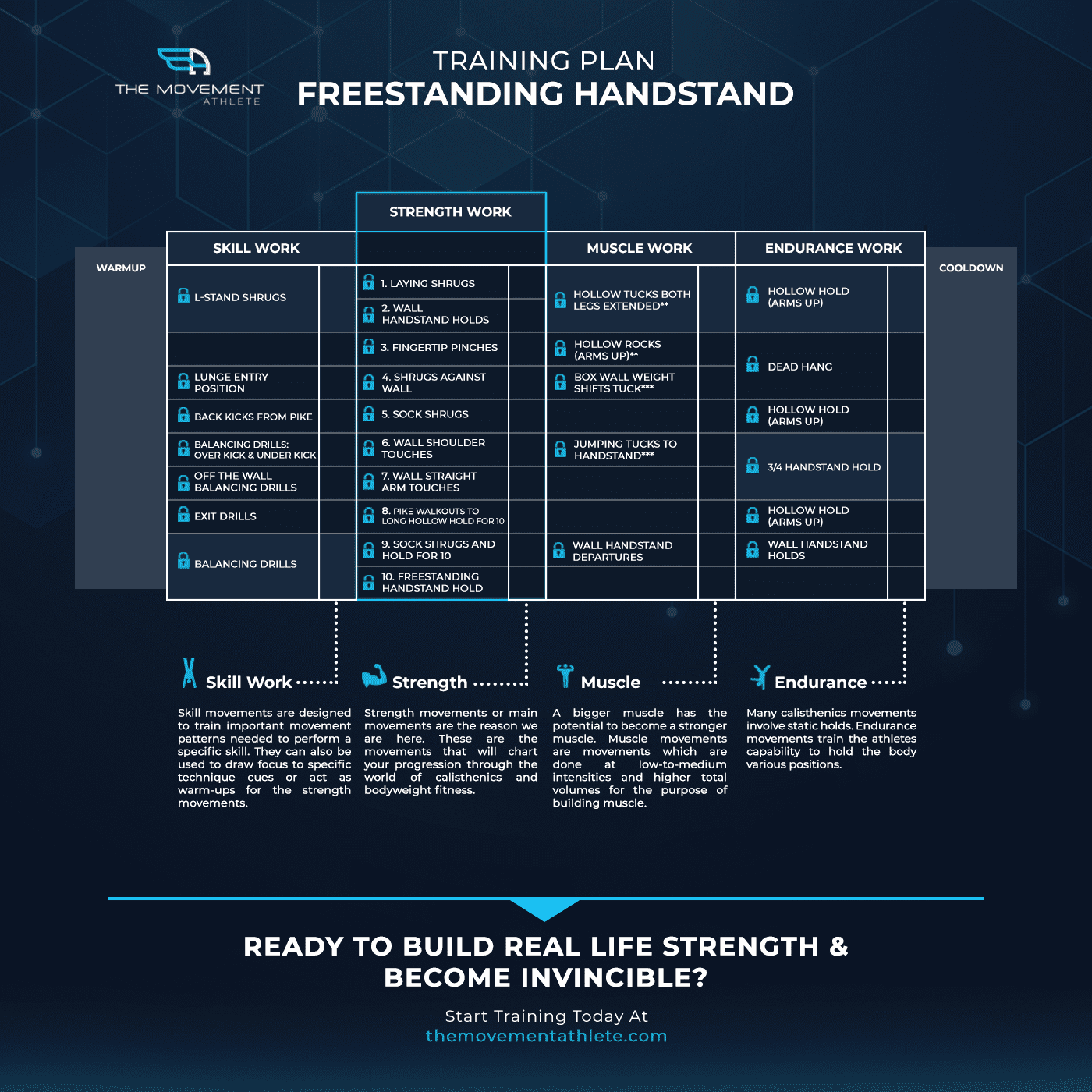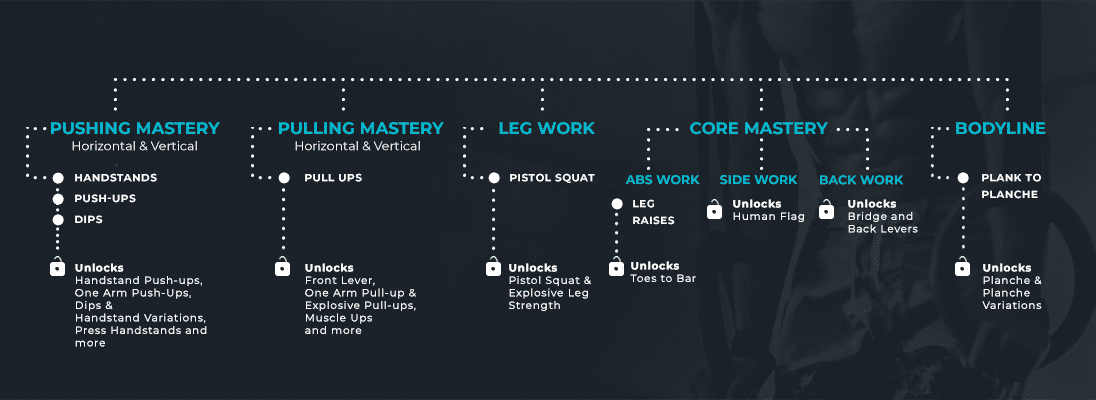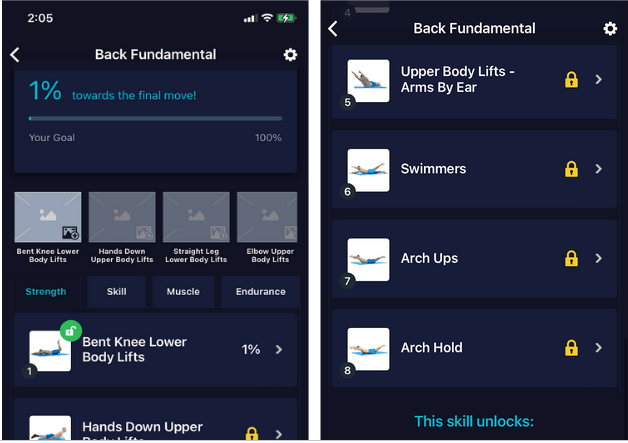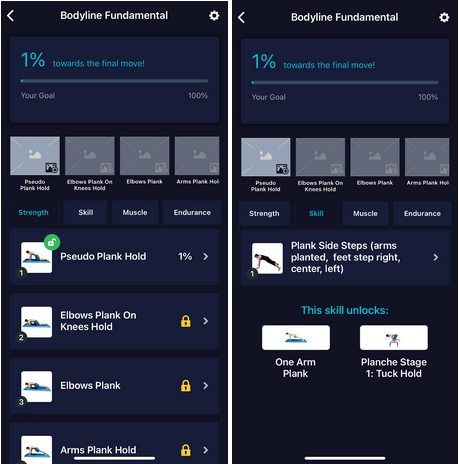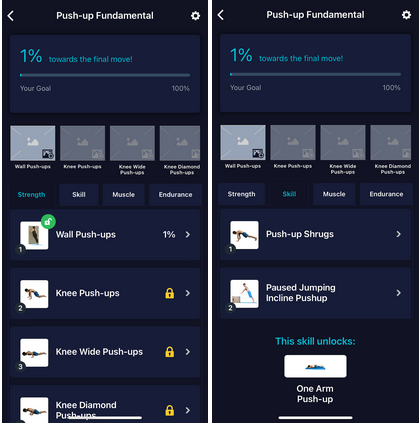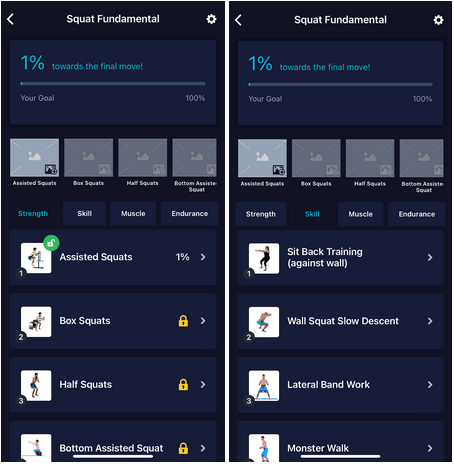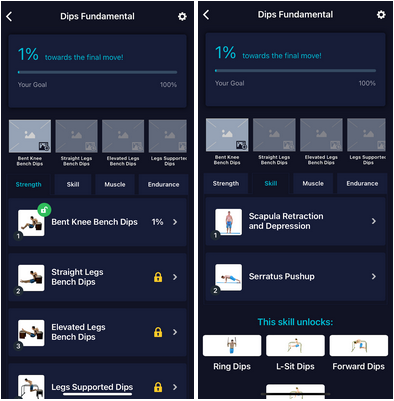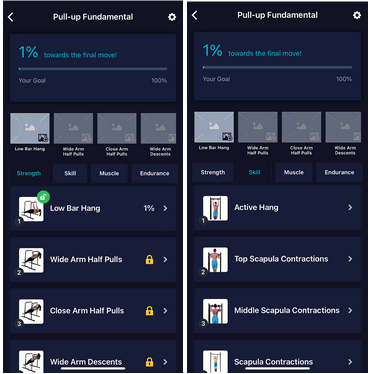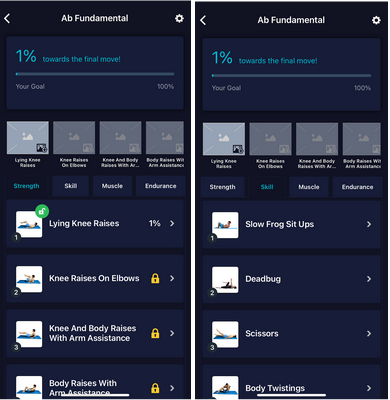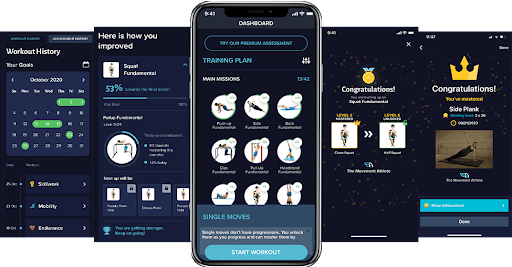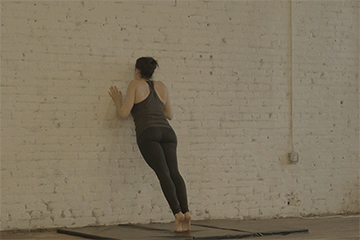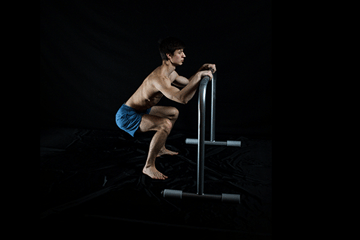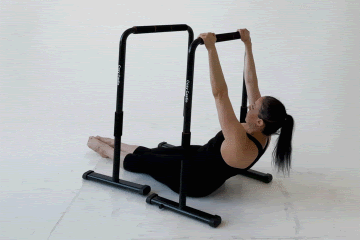☝️So, you’re on a mission to find a calisthenics plan that covers it all. You’re in the perfect place!
We’re about to explore the world of full-body calisthenics, which activates every muscle group without needing heavy equipment or expensive gadgets. It is all about embracing the power and versatility of your own body to achieve a comprehensive workout right in the comfort of your home.
The coolest part? You’ll be using everyday items around your house unexpectedly, turning them into your personal fitness arsenal.
We are here to take it a step further through a series of exercises that are the foundation of a comprehensive workout routine. We want to guide you in creating your personalized calisthenics program, following the Movement Athlete’s philosophy.
Stay with us, and let’s uncover this life-changing strategy together. Ready to get started on this full-body journey? Let’s dive in!
✨Getting Started with Full Body Calisthenics
So, here’s the thing: one-size-fits-all routines just don’t cut it. They might be convenient, but they often miss the mark regarding personalized progress. That’s why we at The Movement Athlete Academy have taken a different approach.
In the past, workouts were broadly labeled as beginner, intermediate, or advanced, a method that restricted athlete development.
Check out this blog, 📍The End of Beginner/Intermediate/Advanced Personalization in Calisthenics Training, which explores why customization is crucial for progress.
The issue? Without personalized training, you’re either over-challenged, risking injury and poor form, or under-challenged, not stimulating enough muscle growth.
That’s where The Movement Athlete Academy comes in, offering personalized workout plans tailored to your level for optimal performance. Sign up for our 📍FREE assessment to get your customized training plan.
Want more info? We outline how to design effective workouts, the key elements of a successful calisthenics routine, and provide a beginner-friendly workout you can do at home.
After our free assessment, you’ll receive a training plan designed just for you. This plan will help you avoid injury and ensure the right exercise fit. It’s a game-changer for achieving your fitness goals. Let’s progress together!
😲How Do You Create the Most Effective Full-Body Calisthenics Workout Plan?
Let’s explore how to tailor a workout perfectly suited to you. Here’s a straightforward breakdown.
Calisthenics is a game-changer, yet its effectiveness hinges on a plan that’s structured, progressive, and customized to your needs. This is precisely the experience that The Movement Athlete Academy offers.
When you join, here’s what to expect:
- ✅Comprehensive Initial Assessments
We start with a detailed assessment to understand your current level, strengths, and areas needing improvement.
It’s crucial to determine your baseline—whether you’re building fundamental strength or are ready for more complex movements. For example, if you’re uncomfortable with pushups, we can identify your progression stage. Or, you might have the strength for a handstand but lack the necessary mobility. These insights are vital for developing a tailored training program.
- ✅Personalized Training Plan
Based on your assessment, we craft a unique training plan focused on the skills you need to develop and outline a strategy for progression. Mastering pushups, for instance, signals that you’re ready for more challenging pushup exercises.
- ✅Daily Adaptive Workouts
You’ll get daily exercises that evolve with your feedback and progress, similar to advancing through levels in a video game. As you progress, the challenges increase.
Why take this approach? Because this isn’t just a short-term program; it’s an opportunity to embark on a lifelong journey toward calisthenics mastery.
💥Elements of a Full-Body Calisthenics Routine, Beginner to Advanced
Let’s explore the transformative essence of your training sessions. The core of calisthenics is complex and rich. This practice goes beyond physical strength; it’s about the delicate balance and integration of diverse elements.
For any calisthenics regimen aimed at developing skills, we consistently integrate four fundamental pillars:
✅ Strength
✅ Skill
✅ Muscle
✅ Endurance
Let’s examine each pillar in detail:
👉Skill work: Technique is crucial. We emphasize perfecting movement patterns and specific technical directives to establish a robust base.
👉Strength Work: This forms the core of calisthenics training. We map your progress through diverse strength exercises, tailored repetitions, and series to enhance strength.
👉Muscle Work: Augmenting muscle mass is vital for both strength and overall performance. Our exercises are tailored to engage specific muscle groups and maximize growth potential.
👉Endurance Work: Sustaining positions can be challenging. We bolster your capacity to hold various stances for longer, boosting stamina and tenacity.
The unique aspect of our approach is the integration of these critical components into your training regimen, offering a comprehensive strategy for balanced development.
Thus, each daily session within The Movement Athlete app is meticulously crafted to include these essential elements: warm-up and mobility exercises, skill work, strength work, muscle enhancement, endurance improvement, and a cooldown with flexibility exercises.
This is how it looks inside our app:
👊Why Start with the Fundamentals?
Beginning with the fundamentals in calisthenics is key, and this point can’t be emphasized enough. Getting into complex moves like the human flag or planches reveals that strength alone isn’t enough.
Advanced calisthenics movements also demand flexibility, mobility, balance, and skills honed through dedicated practice.
Here’s a simpler look at why the fundamentals are so important:
- ✊ Skills Beyond Strength: Advanced moves require not just strength but also how well you use your body. Flexibility, mobility, balance, and precise technique are all critical. The basics are where you build these skills, ensuring you’re ready for anything.
- ✊ Step-by-Step Progress: Learning calisthenics is about moving forward step by step. Trying advanced moves too soon is like running before you can walk, leading to frustration or injury. Start with the basics to build a solid foundation of strength, flexibility, and skill.
- ✊ Safety First: Jumping into advanced moves too early can increase injury risk. Basics teach you the right form and prepare your body, making sure you’re ready for more challenging moves safely.
- ✊ Smart Training: Stick to the basics to maximize your workout time. This will help you see faster, lasting progress and keep you motivated as you improve.
- ✊ Unlocking Advanced Moves: Once you’ve completed the basics, you’re set to tackle any advanced move. These fundamental skills are the building blocks for everything in calisthenics, making learning new techniques easier.
- ✊ Overall Development: Starting with the basics supports a full-body approach to fitness, balancing strength, flexibility, mobility, balance, and skill. This well-rounded development is what enables calisthenics practitioners to achieve impressive feats.
The fundamentals are the cornerstone of any successful calisthenics practice. They ensure that you develop the broad base of skills needed not just to perform impressive moves but to do so with grace, efficiency, and, above all, safety. By prioritizing these foundational elements, you set yourself up for a rewarding journey that can take your physical abilities to heights you never imagined.
🧐How to Create a Full Body Calisthenics Routine
🎯Step 1: Assessment – Determining the Right Exercises for You
Before diving into any workout regimen, it’s crucial to assess your current fitness level, strengths, weaknesses, and goals. This ensures that the exercises you choose are both challenging and achievable, minimizing the risk of injury and maximizing progress.
The Movement Athlete offers ASSESSMENT to gauge your fitness and recommend exercises tailored to your capabilities. This program is designed to meet your needs and offers an extensive range of full-body calisthenics workouts.
It is an exceptional resource, filled with various exercises, dietary insights, fitness knowledge, and additional learning materials from expert instructors experienced in teaching full-body calisthenics routines.
There’s no time to lose—empower yourself to become stronger.
🎯Step 2: Creating Your Workout and Exercises
Depending on where you are in your calisthenics journey, your training could start with mastering fundamental movements or advance toward more complex skills, ensuring a personalized approach to full-body calisthenics.
Beginning with the fundamentals of calisthenics is essential, regardless of your fitness level. This approach ensures you develop a strong foundation of strength, flexibility, and technique, crucial for preventing injuries and enabling further progression.
So, what are those fundamentals?
🤸The 9 Fundamentals to Full Body Calisthenics
Fundamentals can help you get a balanced workout that challenges every major muscle group, promotes muscular symmetry, and enhances functional strength. These movements facilitate progress towards more advanced calisthenics movements and support long-term physical health and performance.
Each fundamental component contributes to the overarching objective of full-body calisthenics: to build a resilient, versatile, and powerful physique capable of complex movements and challenges. Here are the 9 calishtenics fundamentals inside the Movement Athlete app:
- 🏆Side Fundamental: Essential for developing lateral stability and strength, side fundamentals like side planks and side holds target the obliques and lateral chain of the body. Side fundamental exercises ensure a balanced development of core stability and side-to-side movement capability.
Here’s how this fundamental looks inside the app:
- 🏆Back Fundamental: Strengthening the back is crucial for posture, power, and preventing injuries. Exercises such as yoga bridge lifts and back planks focus on the upper and lower back muscles, contributing to a solid foundation for upper body strength and endurance.
See what the back fundamental looks like inside the app:
- 🏆Bodyline Fundamental: The bodyline exercises enhance core strength and stability. Planks, hollow holds, and arch holds are pivotal for building a strong, stable trunk, which is essential for safely and effectively performing advanced calisthenics movements.
Here’s what the bodyline fundamental looks like inside the app:
- 🏆Push-up Fundamental: A cornerstone of upper body strength, the push-up and its variations target the chest, shoulders, and triceps. Mastery of push-up fundamentals paves the way for more complex pushing movements and ensures balanced muscle development.
- 🏆Handstand Fundamental: Training for handstands cultivates balance, upper body strength, and control. Progressing through handstand fundamentals, from wall-assisted handstands to freestanding ones, dramatically enhances proprioception and upper-body muscular endurance.
- 🏆Squat Fundamental: Essential for lower body strength, squat variations, including wall squats and box squats, build power in the legs and glutes. Squats also improve lower body mobility and stability, forming a critical aspect of full-body fitness.
- 🏆Dips Fundamental: Dips focus on the triceps, chest, and anterior deltoids. Whether performed on parallel bars or rings, dip fundamental contributes significantly to upper body pushing strength and muscular hypertrophy.
- 🏆Pull-up Fundamental: A true test of upper body pulling strength, pull-ups engage the back, biceps, and forearms. Mastery of pull-up variations is key to developing a strong, muscular back and enhancing upper body muscle balance.
- 🏆Ab Fundamental: Core strength is the foundation of calisthenics. Exercises targeting the abdominals, such as leg raises, crunches, and twists, fortify the core, supporting advanced calisthenics skills and improving athletic performance.
So, what does your full-body workout look like?
| Calisthenics Workout | Step | Number of reps |
| Push-Ups | Step 5 | Reps x |
| Pull-Ups | Step 8 | Reps x |
| Dips | Step 5 | Reps x |
| Squat | Mastered | Unlock Pistol Squat |
| Ab Fundamental | Step 4 | Rep x |
Can you see how granular it gets? This precision is crucial because a one-size-fits-all workout plan could lead to ineffective training sessions or, worse, injuries. As you exercise, you progress through the specific stages you focus on, bringing you closer to your objectives.
This approach not only allows you to monitor and visualize your advancements but also ensures you’re following the most efficient route toward achieving your fitness goals.
In the bigger picture, this is what a journey toward a free-standing handstand would look like:
Here’s your whole calisthenics journey and training plan looks inside the Movement Athlete app:
Tips for Success
- Progression: Gradually increase the number of reps or sets as you get stronger or adjust the exercises’ difficulty.
- Consistency: Aim to stick with the routine for at least 4-6 weeks to see noticeable improvements.
- Listen to your body: If you feel pain (not to be confused with the normal discomfort of working out), stop and assess. Ensure your form is correct to prevent injury.
🥇Benefits of Personalized Full-Body Calisthenics Workout
Personalized full-body calisthenics offers multiple benefits for your fitness journey:
- Balanced muscle development: Targets every major muscle group for a harmonious physique .
- Enhanced functional strength: Improves strength for daily activities and manual tasks
- Workout anywhere, anytime: No equipment needed, offering flexibility in your fitness routine.
- Advanced movement mastery: Progression in calisthenics leads to impressive feats of strength and balance.
- Straightforward progression: Easily adjustable exercises to challenge your body as you grow stronger.
- Quick recovery: Lower risk of injury and faster recovery than heavy lifting, allowing for more frequent training.
- Variety keeps it interesting: A wide range of exercises prevents boredom and boosts motivation.
- Insane strength: Calisthenics leverages body weight for resistance, effectively building relative strength.
- Holistic approach: The approach is holistic, enhancing not just strength and muscle but also balance, endurance, body control, mobility, and flexibility.
- Keep it fun: The variety of exercises available keeps the training engaging and motivational, working all muscle groups creatively.
This concise approach underscores the versatility and effectiveness of calisthenics for achieving peak physical fitness.
List of Best Full Body Calisthenics Workouts You Can Start with as A Beginner
| Exercise | What it Targets | How to Perform |
|
Wall Push-ups |
Chest, Tricep |
|
|
Pseudo Plank Hold |
Shoulder, Glute, Back, and Core |
|
|
Assisted Squat |
Glutes, Quads, and Hamstrings |
|
|
Bent Knee Bench Dips |
Chest, Triceps, and Deltoid |
|
|
Low Bar Hang |
Shoulders, Chest, Triceps, Biceps, Lower back, Abs, and Core |
|
|
Lying Knee Raises |
Abs, Core |
|
🏃Where Does Mobility Fit In?
The strength exercises above are pivotal for muscle development and power, and their potential is unlocked when executed with perfect form.
These exercises not only foster strength but also enhance mobility by promoting flexibility across a broader range of motion. Static stretching can help with mobility, but strength exercises are more effective.
🧐Frequently Asked Questions
🔎 What are full body calisthenics?
Full-body calisthenics utilizes bodyweight exercises to target all the major muscle groups in a single workout session. It emphasizes compound movements and functional strength.
🔎 Can beginners do full body calisthenics?
Yes, beginners can start with full body calisthenics. It’s adaptable to all fitness levels, with exercises easily modified to match individual abilities. Progression is straightforward, making it suitable for beginners to build strength and skill gradually.
🔎 How often should I do full body calisthenics workouts?
Frequency can vary based on your fitness level and goals, but starting with 3 full-body workouts per week allows for adequate rest and recovery. As you progress, you might adjust the frequency based on how your body responds.
🔎 Do I need equipment for full body calisthenics?
No, one of the advantages of calisthenics is that it requires minimal to no equipment. Exercises utilize your body weight for resistance, though basic equipment like pull-up bars can expand your exercise options.
💥Conclusion
Diving into full-body calisthenics with The Movement Athlete Academy introduces a personalized and holistic approach to fitness, prioritizing tailored workouts over generic routines. This philosophy ensures exercises are aligned with individual fitness levels and goals, fostering safe and sustainable progress.💯
🤜The program begins with an in-depth assessment, crafting a workout plan that evolves with your achievements and challenges, encapsulating strength, skill, muscle, and endurance into a cohesive routine.
Ultimately, this approach isn’t just about short-term gains but embarking on a lifelong journey towards mastering body control, achieving peak physical fitness, and unlocking the full potential of bodyweight training.
Take the assessment now to discover your current level across the nine fundamentals of calisthenics. Understanding your starting point is crucial to mapping your fitness journey and setting clear, achievable goals.🎯


